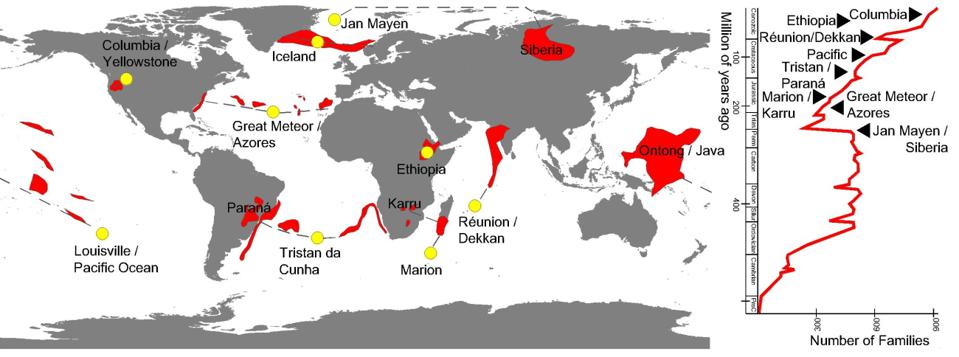PALEONTOLOGISTS FIND 27 MILLION YEAR CYCLE IN EARTH’S MASS EXTINCTION

By: David Bressan
Photo: Forbes
Mass extinctions of land-dwelling animals—including amphibians, reptiles, mammals, and birds—follow a cycle of about 27 million years, coinciding with previously reported mass extinctions of ocean life, according to a new analysis published in the journal Historical Biology.
The study also finds that these mass extinctions align with major asteroid impacts and devastating volcanic eruptions.
Paleontologists recognize five big mass extinction events in the fossil record. At the end of the Ordovician period, some 443 million years ago, an estimated 86% of all marine species disappeared. At the end of the Devonian period, some 360 million years ago, 75% of all species went extinct. At the end of the Permian period, some 250 million years ago, the worst extinction event so far happened, with an extinction rate of 96%. At the end of the Triassic period, some 201 million years ago, 80% of all species disappeared from the fossil record. The most famous mass extinction happened at the end of the Cretaceous, some 65 million years ago, when 76% of all species went extinct, including the dinosaurs. Minor extinction events mark the end of the Carnian age, about 233 million years ago, and the transition from the late Eocene and early Oligocene period, about 36 to 33 million years ago, coinciding with the Popigai impact.
The authors examined the record of mass extinctions of land-dwelling animals and concluded that they coincided with the extinctions of ocean life. They also performed new statistical analyses of the extinctions of land species and suggest that those events followed a similar cycle of about 27.5 million years.
The authors also compared the ages of extinction events with the ages of impact craters, created by asteroids and comets crashing to the Earth’s surface, and the ages of flood basalts, the results of a giant volcanic eruption or series of eruptions that cover vast areas with lava and emit large quantities of greenhouse gases into Earth’s atmosphere.
“These new findings of coinciding, sudden mass extinctions on land and in the oceans, and of the common 26- to 27-million-year cycle, lend credence to the idea of periodic global catastrophic events as the triggers for the extinctions,” said Michael Rampino, a professor in New York University’s Department of Biology and the study’s lead author. “In fact, three of the mass annihilations of species on land and in the sea are already known to have occurred at the same times as the three largest impacts of the last 250 million years, each capable of causing a global disaster and resulting mass extinctions.”
The researchers also suggest another possible explanation for mass extinctions beyond asteroids. All eight of the studied mass die-offs on land and in the oceans matched times of flood-basalt eruptions. Flood-basalt eruptions, lasting several millennia, release toxic gases into Earth’s atmosphere, causing extreme warming and – as gases are washed by rain into the sea – acidification of the oceans. Dramatic changes in chemical weathering rates in a warmer world and altered nutrient input and productivity in the sea leads to widespread deoxygenation and sporadic sulfide poisoning of the oceans. The resulting environmental collapse will wipe out a wide variety of animal and plant groups.

“The global mass extinctions were apparently caused by the largest cataclysmic impacts and massive volcanism, perhaps sometimes working in concert,” added Rampino.
As for what controls this supposed periodicity of mass extinctions on Earth no conclusive explanation has yet been given.
According to the controversial Nemesis hypothesis, a theoretical companion star to our own might be in an enormous orbit that stirs up comets and flings them our way every 26 million years. The occurrence of flood-basalt eruptions every 25 to 30 million years could be the result of long-term cycles of plumes rising up in Earth’s mantle.



